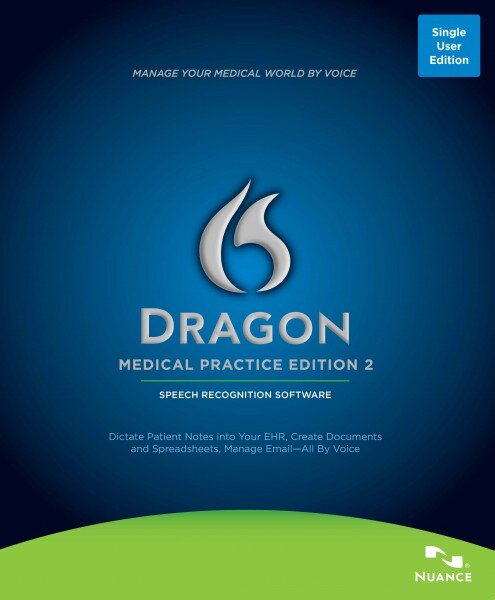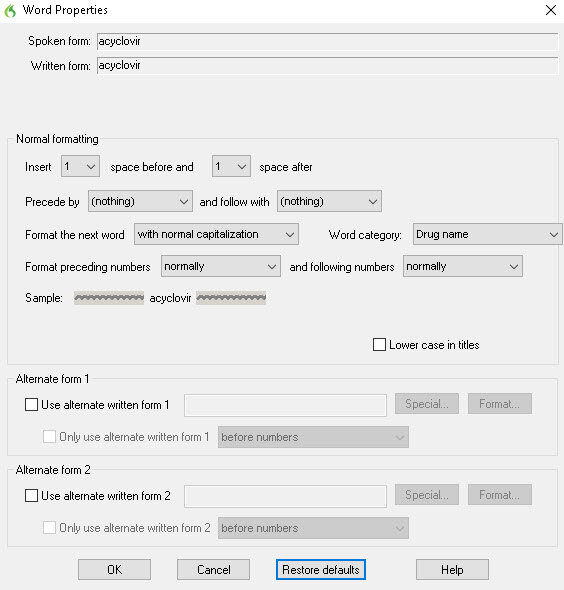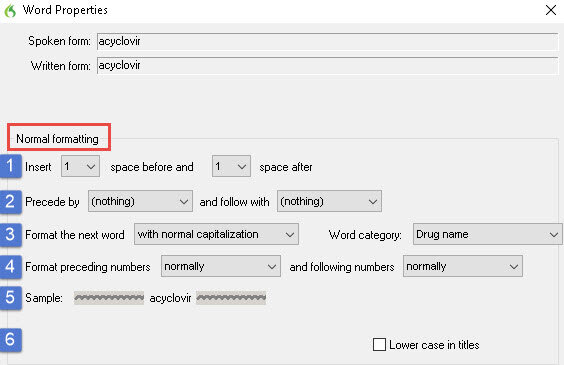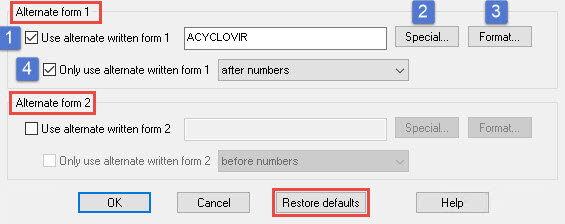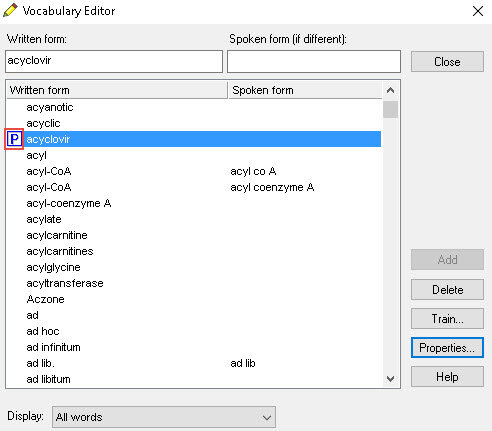Dragon Medical Word Properties
You may already know about using spoken and written forms to customize how your words display. But there’s another method for manipulating how Dragon® Medical Practice Edition 2 transcribes your words.
In Dragon Medical, each vocabulary word has word properties. Using these properties allows you to configure words to appear a specific way—whether related to spacing, lines and paragraphs, capitalization, or context.
Before we go any further, also note that we’re working with Dragon Medical Practice Edition 2 for Windows. The layout is only slightly different for the Mac edition of Dragon Medical, and the functionality is almost identical, so Mac users should be able to benefit from this information as well.
If you have an earlier version of Dragon Medical, such as Dragon Medical Practice Edition 1 or Dragon Medical 10, you will still have access to word properties. But, there may be some particular features that are only available in the latest version, Dragon Medical Practice Edition 2.
What Are Word Properties?
In Dragon Medical, word properties allow you to configure how many spaces go around a particular word, determine what kind of capitalization the surrounding words get, insert line and paragraph breaks, and more. You have the flexibility to set up a very specific set of display properties for any given word. You can even have the word show up completely differently when numbers are involved.
We know doctors and other healthcare professionals often need their text to look a certain way, whether due to formatting restrictions or workflow requirements, for ease of use, or simply because of a personal preference. In conjunction with the written form of the word, word properties provide the functionality you need to document patient encounters, send emails, and write referrals with the appropriate formatting.
Here are some cases where word properties would be useful:
- I need a word to display differently if it comes after numbers.
- When I dictate this word, it should create a new paragraph automatically.
- I want the cursor to tab when I say this word.
- The word after this one should always be capitalized.
- I want a new line after this word.
Keep in mind that for some of these cases, there are voice commands that can be used instead. What we’re going to discuss relates to the automation of specific formatting related to a word—so that you never have to use an extra command when you dictate that word.
How to Find Word Properties
First of all, be aware that word properties are profile and vocabulary specific. If you configure a word in one profile and then create another profile, the configuration won’t transfer automatically. If you have multiple vocabularies attached to one profile, you’ll need to either make the change in each vocabulary, or export/import those words to the other vocabularies.
Once you’ve determined which vocabulary to make your changes in, from the DragonBar, go to Vocabulary > Vocabulary Editor. When the Vocabulary Editor window opens, find a word you want to edit and click the [Properties] button.
You should now be looking at the Word Properties window. Let’s walk through each of these sections, starting with “Normal Formatting.”
Get Help With Dragon Word Properties
Would you like assistance with your word properties? Click the button below to get started.
Get Dragon Support
Normal Formatting Options
The “Normal Formatting” module, located at the top of the Word Properties window, controls the formatting for normal use of the word in question. Every time you dictate this word, these properties are used.
Let’s discuss the functionality available here, row by row.
Row 1
Here’s where you indicate how many spaces should precede and follow the word. Normally, there’s one space on either side, but you have options ranging from 0-2. You might use this option to make the word easier to see when used with other words.
Row 2
These options let you configure whether you want the word to start on a new line, or in a new paragraph. You can also have a line/paragraph break come after the word. This helps when you want to create a new section or section header in your document.
Additionally, you can use a tab before the word, to indent it, or after the word, to push the following dictation to the right. This is excellent for report formatting.
By the way, we don’t recommend using the tab formatting feature like a command. Your word will still be printed if you do, and Dragon Medical already has a tab command that you can use.
The phrase for the tab command is “press tab.”
Row 3
This row is about capitalization, and features two distinct sections. In the first part, you can configure the capitalization of the word that follows this word. Choices include normal, initial caps, all caps, or lowercase.
The second section, labelled “Word category,” is actually quite powerful. If you assign a word a particular category, whether “Person,” “Department,” or “Drug,” you can control how it gets capitalized using the Auto-Formatting Options. Go to Tools > Auto-Formatting Options and click on the “Capitalization” tab.
The first three options that you will see apply to any words in these categories. “Person” and “Department” allow you to select “Standard” or “All Caps,” and “Drug” allows you to pick either “Standard,” “Initial Caps,” or “All Caps.”
Any word that you have put in a particular category will always be capitalized according to the rules that you set in the Auto-Formatting window.
Row 4
These settings give you the option to format numbers before or after the word. You can leave it as “normal,” you can force Dragon Medical to always give you numerals (5, 15, 30), or you can set it up for Roman numerals.
Row 5
This row simply displays what your new rule will do to the word in question, as well as the words around it. As you select formatting options, the squiggly lines will change to reflect capitalization changes and line breaks, numbers will appear in the correct format, and spacing around the word will adjust itself.
Row 6
If you want this word to be lowercase in titles, check the box next to “Lower case in titles.” Note that this will not override written forms or auto-formatting rules. If you select a phrase where your word is not the first or last, and then use the “cap that” command, the word will stay lowercase.
What Are Alternate Forms?
The two “alternate forms,” located at the bottom of the Word Properties window, allow you to create a different written form of this vocabulary word. Depending on configuration, Dragon Medical can either always use this alternative written form, or only in certain conditions.
In the picture below, we’ve labelled the four main sections that we’ll be discussing.
Section 1
In this part of the configuration, if you check the box, Dragon Medical will display whatever is in the text field when you dictate this word. Be sure to type an alternate form of the word in the field next to “Use alternate form 1.”
Unless you check the box in section 4, Dragon Medical will always transcribe your word as you set in the text field. The difference between this method and the written form/spoken form method is that this word will still appear normal in the Vocabulary Editor—making it easier to find.
Also, keep in mind that you need to say this word normally—do not change your dictation of this word based upon the alternate form.
Section 2
The [Special] button allows you to insert a tab, new line, or new paragraph for the alternate form. It’s exactly like the option in row 2 of the normal formatting options.
Section 3
The [Format] button gives you all the normal formatting options from the top half of the window for your alternative form. The only exception is that there is no word category available.
Section 4
The checkbox next to “Only use alternate form 1” allows you to tell Dragon Medical when to use your alternate form. If your word isn’t used in one of these cases, it will print the written form, normal formatting options included:
- When preceding numbers
- Between two sets of numbers
- Following numbers
There are several cases where you might want to use an alternative form. For example, choose the “After numbers” option, and when you dictate dosages, you can set an abbreviation for your word.
Miscellaneous
- “Alternate form 2” is exactly like form 1. It just gives you another set of options for a second alternative form.
- If you want to erase all any of the configurations you’ve made in the Word Properties menu, click the [Restore defaults] button at the bottom of the window. The word will reset to reflect the formatting it had when you installed Dragon Medical Practice Edition 2.
More About Word Properties
Finding Words
When searching your Vocabulary Editor for words that you have configured properties for, look for the blue square icon with the capital ‘P’ to the left of the word.
Micrograms Not Mu (µg)
If you are having a problem getting micrograms to display as “micrograms,” rather than “µg,” which is a change that can be made using word properties, see this article.
More About Words and Vocabularies
To find more information about Dragon Medical vocabularies and vocabulary words, see this article.

